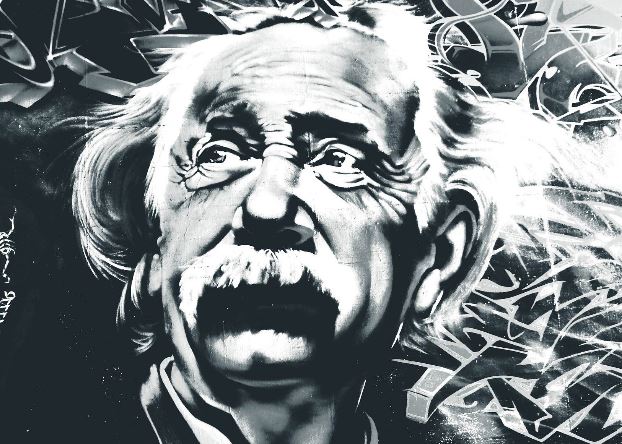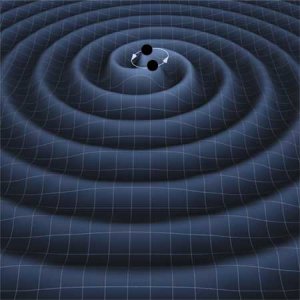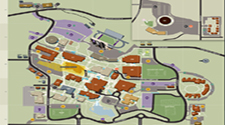Point 1: To detect so many events in such a short time implies that black hole mergers are far more common than anyone thought, happening 20 times more frequently than astronomers expected! This is interesting because it means that binary black holes are more common than we thought, which may mean they can form in ways we haven’t thought of yet!
Einstein was wrong!
But not for the reason you think...
February 7, 2019
by Stacy Palen, Physics Professor and Ott Planetarium Director

Two or three times a year, an interested person sends me a lengthy paper in which they believe that they have “proved Einstein wrong”. These papers are usually about relativity: the odd effects on space and time that occur when traveling fast or near a black hole. You’ve seen Interstellar, right? That’s relativity. I usually glance over these papers and hit delete. Relativity has been tested time and time again, and it will take an extraordinary observation to overturn this theory.
But in 2016, astronomers announced that they had, in fact, proved Einstein wrong. Way back 100 years before, in 1916, Einstein published a paper laying out his Theory of General Relativity. In this paper, he predicted that gravitational waves should exist. Then he calculated the effect of such waves, as they pass through an object. As a gravitational wave passes through an object, it stretches and compresses it. This effect is called the “strain”, and it’s calculated by dividing the change in length by the length of the object. For example, a gravitational wave might stretch a one-meter stick by 0.000000000000000000001 m (10^-20 m, in scientific notation). This gives a strain of 10^-20. A kilometer would likewise be stretched by 10^-20 km. Einstein looked at that “-20” in the exponent and decided that humanity would never be able to measure an effect that small.
But he was wrong.
For 100 years, astronomers built gravitational wave detectors. They failed to convincingly detect gravitational waves; although some people thought they did, no other scientists could repeat those results. In the late 1980s, astronomers started thinking about building a very large observatory called LIGO. They designed and engineered and wrote proposals and lobbied Congress and the National Science Foundation and private foundations. In the early 1990s, they broke ground on the new observatory.
In the early 2010s, the team completed the observatory and took data for the first time. They didn’t expect to see any gravitational waves, because they knew their instrument wasn’t sensitive enough. But they DID expect to see vibrations from trucks passing by on a nearby highway. They expected to see vibrations from the wind blowing by. They expected to see vibrations from small earthquakes and high-pressure systems and thunder and herds of deer. They spent the first run of data figuring out what all those sources of noise look like to the detector, so they could distinguish them from actual gravitational waves later.

waves from two orbiting black holes.
[Image: T. Carnahan (NASA GSFC)]
Then they paused, to build Advanced LIGO, which is much more sensitive and incorporates more ways to stabilize the system against all those noisy vibrations. The astronomers expected that in the second science run, over several months, they might possibly maybe detect gravitational waves (but probably not). If not, well, there was a third science run planned, which would be even more sensitive than Advanced LIGO. Within three days of turning on Advanced LIGO in September 2015, the team observed gravitational waves from a pair of colliding black holes! In that second observing run, which lasted until December, the team made three detections in total.
Between September and February, the team wrote multiple papers about the detection, and sent them to peers for review, with strict instructions not to talk about it. They submitted the articles to journals, where they were “embargoed”---that is, kept secret. Everyone involved did an amazing job keeping quiet about the discovery, even though they were all absolutely bubbling over with excitement. It came as a big surprise in February 2016, when the LIGO team held a press conference and announced the discovery. The journal papers were released at the same time, and media around the world picked up the story: Einstein had been proved wrong; it was possible to detect gravitational waves!
At the American Astronomical Society Meeting in January 2019, gravitational wave scientists presented data from the third science run. LIGO has now detected ten gravitational wave events; 9 were mergers of black holes, and one merger of two neutron stars. Astronomers (but probably not anyone else) consider ten a large enough sample to start doing statistics! These results were presented at the meeting in January. Two points stood out to me:
Point 2: The sizes of the black holes involved in all nine black hole mergers indicate that there is a “mass gap” for black holes: nature forms small black holes (a few times more massive than the Sun), and large black holes (more than 50 times as massive as the Sun), but does not form black holes with 30 times the mass of the Sun. That's weird, and astronomers are currently building thousands and thousands of black holes inside their computer simulations to try to figure out why.
The detection of gravitational waves is a fundamental change in the way humans view the universe; it marks the dawn of “multi-messenger astronomy”. Until 2015, astronomers could use only light to study the universe. Now we can study vibrations of space itself, caused by the motion of distant masses. It is an extraordinary achievement of humankind, and yes…a moment when we proved that Einstein was wrong.
Continue learning at the Ott Planetarium
Office hours
Semesters
Monday - Thursday:
6:30 a.m. - 11 p.m.
Friday: 6:30 a.m. - 10 p.m.
Saturday: 6:30 a.m. - 6 p.m. Sunday: Closed
Holidays & Breaks Hours may vary
Mailing address
Weber State University
College of Science
1415 Edvalson St., Dept. 2501
Ogden, UT 84408-2501
